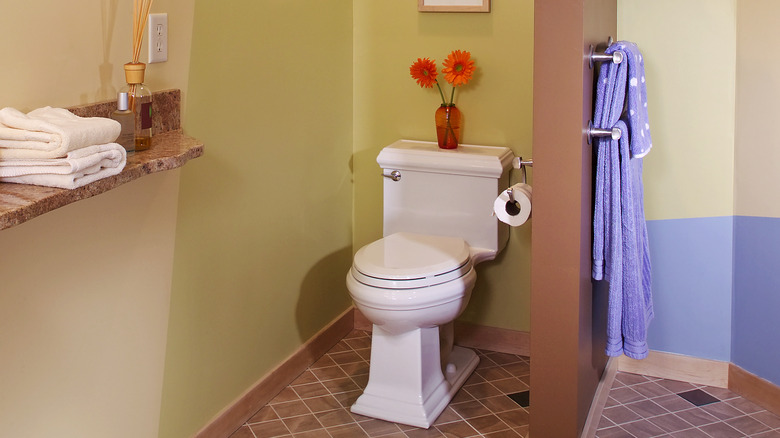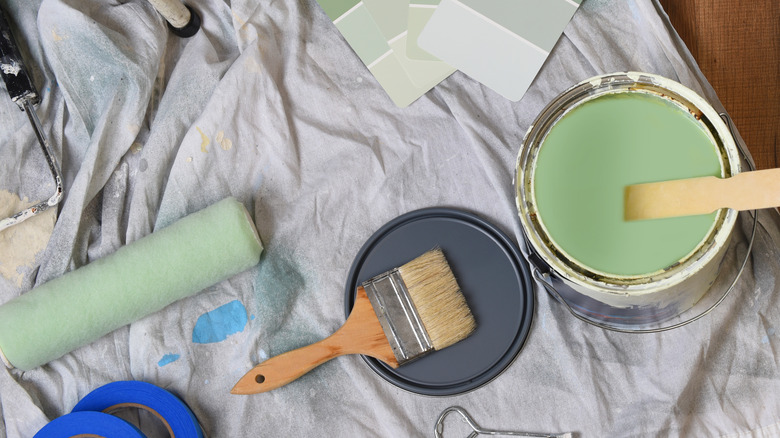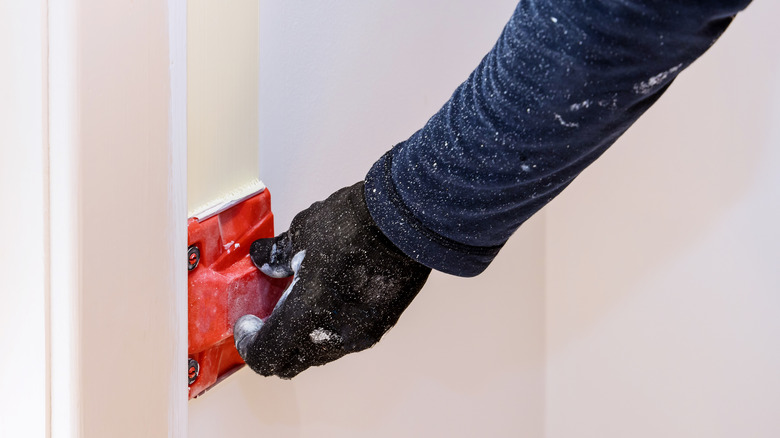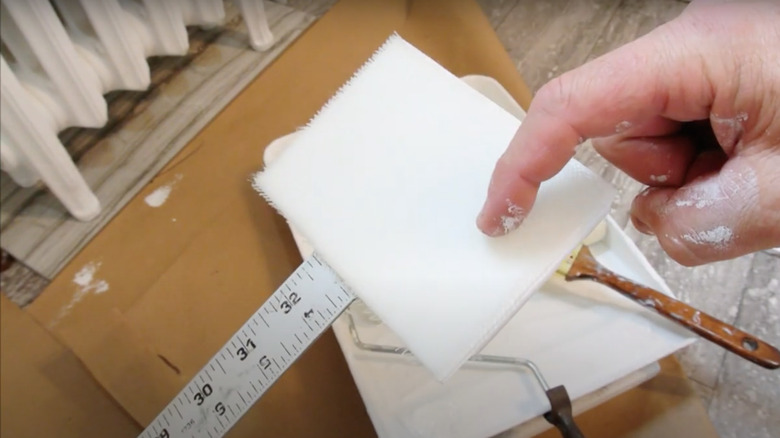Painting Behind A Toilet? These Genius Tips & Tricks Make It Easier
We may receive a commission on purchases made from links.
Painting a bathroom can feel both exciting and daunting. On one hand, you can't wait to give it a fresh and rejuvenated look, but on the other hand, you don't look forward to cleaning up the mess. Moving bath mats and décor isn't too much work, but there's one object in the bathroom that really gets in the way of a good paint job — the toilet. Since toilets only sit a few inches away from the wall, this often leaves an awkward, narrow space between the tank and the wall that's hard to paint with a regular brush or roller.
Detaching a toilet isn't too complicated to do, but it does involve shutting off the water line and other inconvenient steps. Thankfully, with the right tools and methods, you don't have to spend extra time removing a toilet from the bathroom to get the paint job done. There are unique rollers and pads, like edgers and rollers, designed to fit between even the tightest gaps. making it easy to reach and paint that tricky space between the wall and toilet tank. You can also follow these additional tips and hacks to make the process easier and mess-free.
Protect the toilet tank with a garbage bag
You don't want to accidentally drip or smudge paint on your toilet (spending extra time removing stains will be a headache). An easy way to prevent this is by simply covering the toilet tank with a garbage bag. This way, it'll protect your precious loo by catching those paint splatters. What's great about trash bags is that they come in a variety of sizes, slip on easily, and are disposable after use. Plus, they're readily available (most likely already in your house).
Before slipping one on, consider removing the lid of the toilet tank. This can make it a little bit easier to reach and maneuver your paint roller behind it (any extra inch of space counts). Also, depending on the size and shape of your toilet, it may be best to use a larger bag for more coverage. Once covered, you'll want to secure the bag around the base of the toilet to protect that area, too. You can do this with masking tape or duct tape. This will also keep the bag from moving or rubbing up against the wall while you're working. Once you're done, you can just slip off the trash bag and throw it away.
Cover the bathroom floor
It's also a good idea to cover the floor when painting behind the toilet. Even if the toilet is covered from the top, paint can still spill and splatter in every direction. Drop cloths are pretty handy for any painting project, especially in a bathroom. These provide a protective barrier between your paint and the floor, preventing spills and drips from staining or damaging your surfaces.
Canvas drop cloths in particular are made of durable fabric that's capable of absorbing paint spills and reducing the risk of it splashing onto your toilet and other hardware. Not only do they protect your fixtures from paint damage, but it also makes cleanup much easier. When you're done painting, simply roll up the drop cloth and dispose of it (or wash it if it's reusable). If you're on a budget, you can reuse an old bedroom essential as drop cloth instead. It's a great way to repurpose something as well as save some cash.
Use a mini-roller
Since an average-sized paint roller is typically too big to fit behind a toilet, Tiktoker @fromhousetohome revealed how a mini roller can come to the rescue. Mini rollers come in different shapes, lengths, and even vary in nap thickness. For example, you can find a mini roller (like this 10-pack from Amazon for around $9) as thin as 2-inches diameter (or less) to get behind it and touch those hard-to-reach spots. Also, like regular-sized paint rollers, you can attach mini rollers to a long extension handle for extra coverage.
Whether with mini or regular paint rollers, it's always a good idea to use a roller tray. Unlike the paint can, a tray helps keep the paint contained, further preventing spills and drips on the toilet. Using a roller tray also allows you to easily reload your roller with paint without making a mess. Additionally, roller trays usually have a textured surface that helps squeeze out extra paint from your roller. This gives your bathroom walls a smoother, more even coat.
Use a paint edger
Like mini rollers, paint edgers are another must-have for tight painting jobs. Paint edgers are a handy tool for reaching those tricky corners and crevices, especially behind the toilet. These handheld, flat pads are small and lightweight, making them perfect for tight spaces. Unlike paint brushes, which can be messy to clean, the pads on paint edgers typically have flocked fibers that provide a smooth and even finish, ensuring that professional look you love.
If you're looking to add a paint edger to your toolkit, you can find them at your local hardware store, like the 6-inch Multi Painter for Edging and Trimming from Home Depot for under $3. Paint edger pads are available in several different sizes, so try to pick one that's small enough to fit behind your toilet but still easy to hold. Using a paint edger takes a little practice, but once you get the hang of it, you'll be able to apply paint evenly across the entire pad.
Create a DIY paint tool
If the paint edger is hard to maneuver, you can always customize it to fit your space. YouTuber @pocket83² demonstrates how you can combine a paint edger pad with a yardstick to create a DIY extension handle combo. He achieves this by simply attaching the pad at the end of the yardstick and securing it with clear tape. This way, you'll have the length of an extended paint roller as well as the small size of the edger pad.
To keep it from dripping, the YouTuber uses a paint brush to saturate the pads' bristles. He notes in the video that the paint goes on easier in one direction than the other (something to keep in mind). The final and most important tip when painting behind a toilet — don't rush the process. When it comes to painting a space (especially around the tight crevices of a bathroom) it's better to work slowly. Need more guidance for your project? Luckily, there are plenty of tips for perfectly painting your bathroom.



